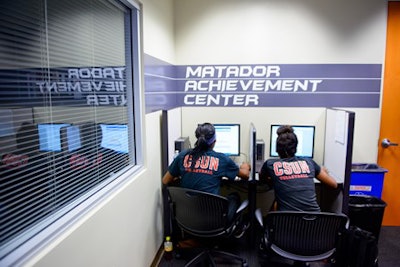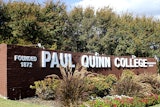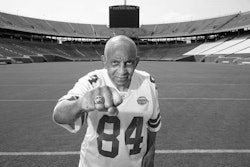 Two student-athletes study in the Matador Achievement Center at California State University, Northridge. (Photo courtesy of Braden Villanueva/CSUN Athletics)
Two student-athletes study in the Matador Achievement Center at California State University, Northridge. (Photo courtesy of Braden Villanueva/CSUN Athletics)California State University, Northridge (CSUN) is like most of the more than 1,000 institutions of higher learning participating in NCAA intercollegiate sports programs. The chances are remote that its students will be among this spring’s Final Four basketball competitors or major winners in another collegiate sport.
Some of CSUN’s student-athletes are emerging from the pack academically, however, by virtue of CSUN’S partnership with the NCAA in the organization’s Accelerating Academic Success Program (AASP).
The AASP, now in its third year of a three-year funding cycle, is an effort by the NCAA to help so-called “limited-resource” institutions receive extra human and technological help for student-athletes who are often unprepared to master the academic requirements of being a full-time student and the demands of a full-scale athletic obligation.
“There are so many schools that need the funds and so many students who would benefit,” says Dr. Brandon Martin, director of intercollegiate athletics at CSUN, a member of the Big West Conference. “We’ve learned that when you provide academic support for a student their potential is unlimited.”
CSUN and AASP
CSUN, now in the third year of a $900,000 NCAA grant, was one of the first six recipients of an AASP grant. The funds are spread over three years with the receiving institution agreeing to match part of the funds each year in cash and in-kind support.
With the NCAA boost, CSUN acquired more campus space for its Matador Achievement Center (MAC) that opened in 2013, which Martin calls the “hub” of the accelerated effort. When the center opened, the school hired four additional staff members to oversee advising, mentoring, tutoring and the office, as well as additional mentors and tutors. “It [the grant] allowed us to have a more comprehensive academic support unit,” he says.
While the final measurements of the results of CSUN’s program and that of other AASP participants are a few years away, Martin and others say the indications are suggesting positive impact and results.
AASP-funded programs, created by the institutions around the needs each school identified in their respective proposals, are helping boost student-athlete academic achievement at the institution, early reports indicate. It is giving faculty and staff a greater appreciation for the myriad challenges faced by students who are athletes. It is also giving faculty in the athletic programs area more reason to expand their reach to colleagues who are as focused on academic achievement as coaches are on athletic performance, say athletic officials at several colleges involved in AASP-funded programs.
CSUN’s experience is reflected at other institutions selected for AASP grants, say NCAA officials and those at several other institutions contacted. For institutions with small athletic budgets and annual losses after expenses, the AASP grants, which ranged from $300,000 a year and go as high as $900,000-plus over the three-year grant period, can make a big difference, they say. Institutions become united, focused and creative, they say, despite the fact that only 50 percent of institutions that qualify for the grant have applied.
AASP and HBCUs
The reasons for the low application rate run the gamut, from not feeling confident about securing the matching grant support — cash and in-kind contributions — to concern about being stigmatized by the NCAA classification of being a “limited-resource” institution.
Brushing aside any stigma concerns, North Carolina Central University (NCCU), a member of the MEAC Conference on the East Coast, secured an AASP grant in 2014 and launched its Preparing to Soar Program (PSP), focusing initially on first-year and transfer student athletes with academic need. With the grant funds, it began with a summer “bridge” program as other institutions had done. PSP added extra mentors and tutors to work with targeted students during the weeks prior to regular registration, helping them adjust to college life and to the added rigors of being a college student-athlete.
“They got that window of time to acclimate,” says Etienne Thomas, associate athletic director/senior woman administrator at NCCU, referring to the student-athletes put in the BRIDGE program. For the student-athletes selected for the BRIDGE PSP, participation was required as a condition of being able to enroll for the school year. Completion of three program courses was necessary and included general education curriculum (GEC) courses such as English and math, “first-year experience” and life skills. Eight hours of college credit were awarded for the courses.
At Coppin State University in Baltimore, one of the initial grant recipients, the institution’s athletic department used part of its grant to create a mobile lab that could be taken on the road for track and field events. While its students are off the field they can use the mobile education lab to catch up on studies. The university even shares the facility with players from other institutions so they, too, can use its computers and other tools to keep studying on the road.
The athletic department at Hampton University, whose president, Dr. William Harvey, is widely credited with championing the original AASP grant idea, was awarded a grant this year. With its funds, it hired four additional people — three academic counselors and an eligibility specialist — and created a classroom on the road with computers and Internet access.
Such resources have long been needed by his and other athletic programs, says Gene Marshall, director of athletics at Hampton. They simply weren’t affordable for institutions such as his with small athletic budgets and students in need financially and academically. Echoing others, Marshall says the added boost is felt campuswide.
“It’s given the faculty assurance the athletic department is with them in trying to graduate students, that we can help our students get better as opposed to just being athletes,” Marshall says.
College athletics veteran Dennis Thomas, commissioner of the MEAC, voices the sentiments of his peers in offering an early assessment of the enhanced NCAA effort.
“The initial data indicates significant positive impact on the success of our student-athletes,” says Thomas, adding that he hoped the NCAA sees merit in continuing the program.
Public pressure
Indeed, the NCAA grant for accelerating academic achievement could not have arrived on the higher education scene at a better time. It came as the NCAA was yielding to public pressure to raise its academic standards for student-athletes and as the nation’s economy was in a freefall with public and private colleges and universities losing public and private support as costs were rising more and more.
The financial blow of athletic programs is such that even the NCAA, by its own count, says, “Of more than 1,100 member colleges and universities in the NCAA, only 20 schools make more money than they spend on sports each year.”
While only a fraction of the $2.7 billion the NCAA says that it awards each year in athletic scholarships, the AASP program, a repackaging of the NCAA’s old “limited-resource” institutions grant program, according to the NCAA, is considered significant by its targeted schools and addresses a variety of challenges and opportunities the NCAA has faced in recent years.
It acted on the polite, yet persistent, urgings of former NCAA board member Harvey to put more of its resources into academic programs for student-athletes needing extra academic support. It gave the organization a firm plan for using some $8 million it received from a lawsuit against it that was settled with the condition its proceeds go to help student-athletes academically. It also gave the NCAA fuel for defending itself from critics who say it is a cash machine with too much attention on athletics and not enough on helping student-athletes succeed academically.
Wendy Walters, a veteran NCAA staffer who coordinates the AASP grant program, says that it appears to be achieving its objectives. She offers a series of examples, such as CSUN and Coppin State, among others, and says they give footing to the staff’s plan to urge the NCAA board next year to renew the program.
In the meantime, the handful of colleges and universities that have benefited from the move by the NCAA are readying plans to make their programs self-sustaining when their three years of NCAA funding expire.
Like CSUN, they want a chance, then another and another, to celebrate academic achievement as CSUN did last spring when it honored 81 student-athletes at its annual “Varsity N” honor roll ceremony. That was more honorees than have ever been. Only students with a 3.2 GPA or higher are honored.
“This program is more valuable than we knew or actually intended,” says Walters. She notes the successes athletic departments have had with their AASP grants have been embraced far beyond athletic departments at some institutions and cited by presidents, too, as approaches that might be adapted for helping the broader student population. “We’re reaching over the fence and having an impact,” says Walters.















